Yesterday, about 32 million Americans were lucky enough to view the total solar eclipse from Earth.
This rare event occurred when the Moon was moving directly between the Sun and Earth, resulting in incredible photo opportunities.
But another select group of humans had a unique vantage point to see the spectacle in full effect: about 420 kilometers above our planet.
Astronauts aboard the International Space Station (ISS) were able to film the moon’s shadow as it plunged the American day into darkness.
In the clip, the 115-mile-wide shadow or ‘umbra’ can be seen moving north, from New York state to Newfoundland, Canada.
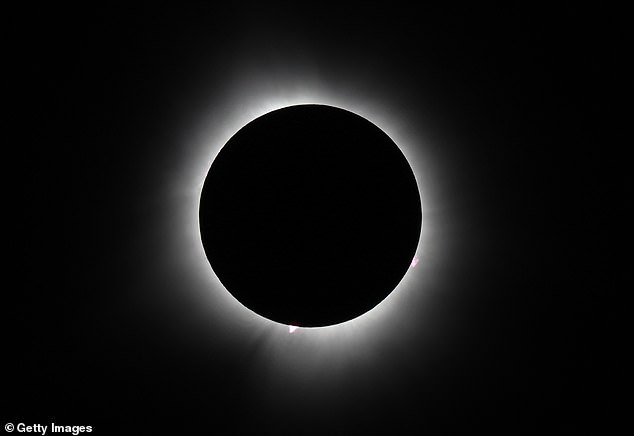
A total solar eclipse is seen from Houlton, Maine, on Monday, April 8, a rare cosmic phenomenon that swept across the United States and parts of Mexico.
POT posted the video on X (Twitter) with the title: Have you ever seen a #total solar eclipse from space?’
“Here’s our astronauts’ view from the @Space_Station.”
The video was filmed by NASA flight engineers Matthew Dominick and Jeanette Epps, two of the seven humans currently aboard the ISS.
NASA said crew members had the opportunity to see the shadow at the end of their workday, which was filled with “cargo transfers, spacesuit maintenance and microgravity research.”
Although the moon’s shadow in the clip passed through New York state, the ISS was parked about 260 miles above southeastern Canada.
Dominick and Epps had the camera pointed south as the round shadow traveled at about 1,500 miles per hour.
From the ISS, a view of the solar eclipse (the moon passing over the sun) was only accessible through a pair of windows on the Roscosmos segment of the space station, NASA said.
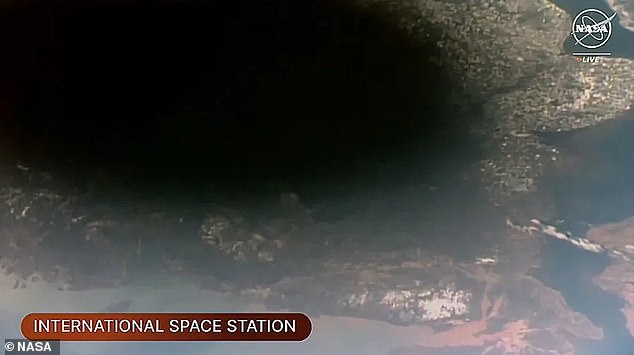

NASA flight engineers Matthew Dominick and Jeanette Epps were inside photographing and videoing the Moon’s shadow on Earth, or umbra, below them. They were orbiting 260 miles above southeastern Canada as the Moon’s shadow moved from New York state toward Newfoundland.
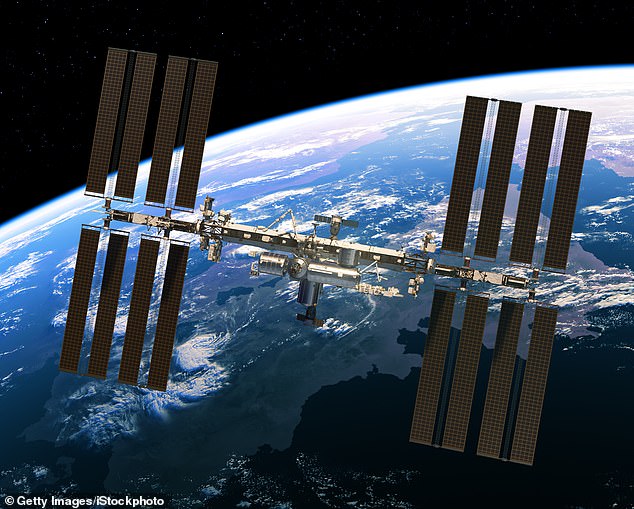

The International Space Station is a large spacecraft in orbit around the Earth, currently occupied by seven humans.
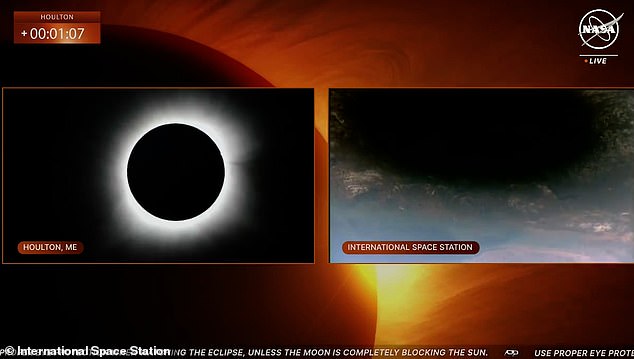

In NASA’s coverage, the view of the eclipse from Houlton, Maine, is broadcast along with a view of the moon’s shadow on Earth from the ISS.
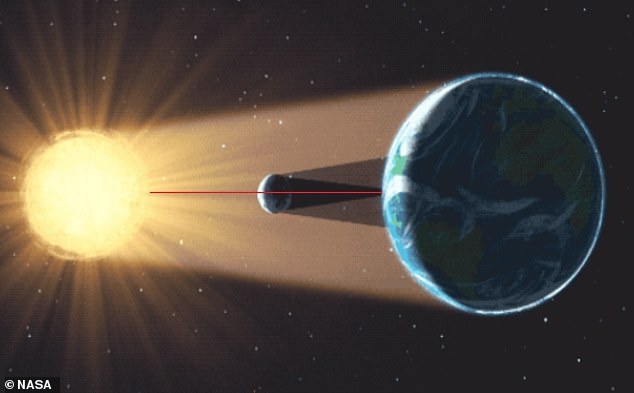

Snapshot during a total solar eclipse: The red line shows the perfect alignment of the center of the sun (left) and the center of the moon (center) with the Earth (right). On Earth, the very center of the moon’s shadow sees a total solar eclipse (where the entire sun is blocked). The rest of the shadow sees a partial solar eclipse (where part of the sun is blocked). People in the rest of the shadow see a partial solar eclipse because the center of the moon is slightly above or slightly below the center of the sun, from the viewer’s perspective. In effect, part of the sun ‘peeks out’ because the sun does not completely block it
However, NASA said the segment “may not have been accessible due to payload limitations.”
But even if the crew members couldn’t see the eclipse, the view of the shadow over Earth provided a pretty surprising alternative.
Dubbed the ‘Great American Eclipse,’ Monday’s rare event marked the first total solar eclipse visible anywhere in the world since December 2021, and the first seen from the US since August 2017.
Its path of totality, where the Moon completely blocked the Sun, traveled from the Pacific coast of Mexico to US states including Texas, Illinois, Ohio and New York in the early afternoon.
He then headed to Canada, passing from the city of Montreal to the provinces of New Brunswick and Newfoundland.
A total solar eclipse occurs when the moon and sun line up perfectly and the moon is close enough to us to cover the entire sun, from our perspective.
“Under these circumstances, the Moon casts a small shadow on the Earth’s surface,” said Dr Robert Massey, deputy director of the Royal Astronomical Society.
“People who are in that shadow as it passes over them are lucky enough to see a total solar eclipse.”
Even outside the path of totality, observers were able to see a partial solar eclipse, in which the sun is partially covered by the moon, making it appear as if a “bite” has been taken out of the sun.
This partial eclipse was expected to also be seen in more western parts of the UK, but was largely obscured by cloud cover.
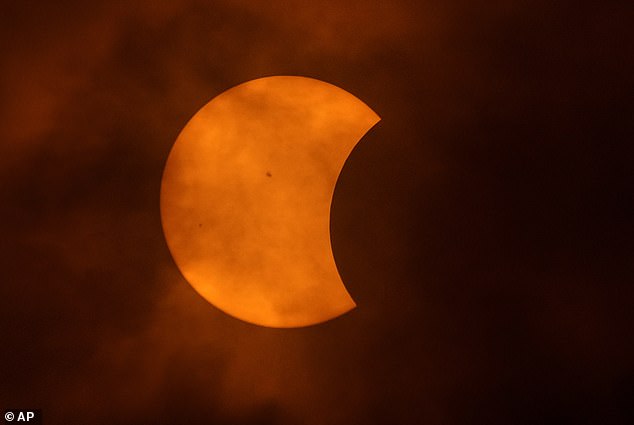

The moon partially covers the sun during a total solar eclipse, as seen from Eagle Pass, Texas, on Monday, April 8, 2024.
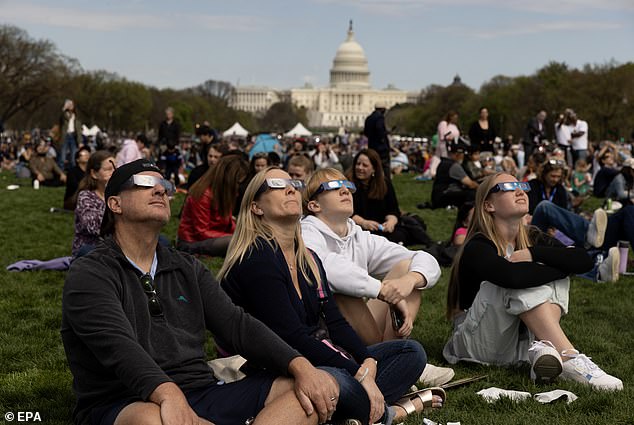

People on the National Mall watch a partial solar eclipse, with the United States Capitol Building seen behind, in Washington, DC, United States. The narrow path of totality passed through 13 US states.
Unfortunately, the next total solar eclipse will not be visible in the UK for another 66 years.
It will occur on September 23, 2090 and will be the first total solar eclipse visible from Great Britain since August 11, 1999, and the first visible from Ireland since May 22, 1724.
After Monday, the next solar eclipse will be an annular solar eclipse on October 2, but it will only be visible from the southern tips of Argentina and Chile, as well as Easter Island in the southeastern Pacific Ocean.
Other parts of South America, including Brazil, Ecuador, Paraguay and Peru, as well as Hawaii and New Zealand, should see a partial solar eclipse that day.
